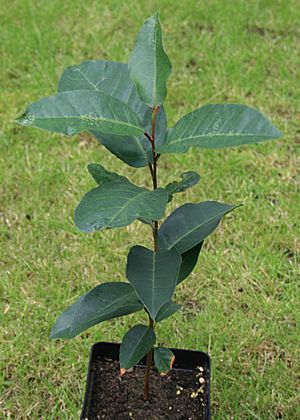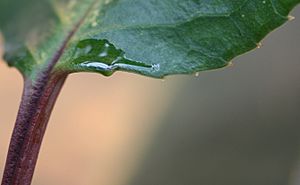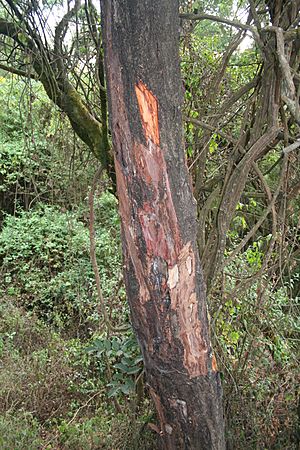African cherry facts for kids
Quick facts for kids African cherry |
|
|---|---|
 |
|
| Conservation status | |
| Scientific classification | |
| Synonyms | |
|
Pygeum africanum Hook.f. |
The African cherry, also known as Prunus africana, is a tall tree found across Africa. It grows in the mountains of central and southern Africa. You can also find it on islands like Bioko, São-Tomé, Grande Comore, and Madagascar. This tree lives at high altitudes, from about 900 to 3400 meters above sea level.
The African cherry is a very tall tree, reaching heights of 30 to 40 meters. It's actually the tallest tree in the Prunus family. It likes moist places with lots of rain, and it can handle some frost. The tree's bark is dark, rough, and often has a cool rectangular pattern. Its leaves are dark green, shiny, and have slightly jagged edges. The flowers are small, greenish-white, and grow in bunches. They bloom from October to May. The fruit is a small, reddish-brown berry with two lobes, each holding a seed. These fruits ripen several months after the flowers bloom.
Contents
About the African Cherry Tree
Just like other trees in the Prunus family, the African cherry has special glands on its leaves. These glands produce a sweet liquid called nectar. This nectar attracts insects that help protect the tree from plant-eating pests.
This tree is important for many reasons. Its wood is valuable, and its bark has been used as medicine for a long time. The fruits are also a key food source for many animals. Birds and mammals that eat fruit love the African cherry. For example, Dian Fossey noted that mountain gorillas really enjoy eating these fruits. The tree's habitat is also home to rare animals like the Carruther's mountain squirrel.
How People Use This Tree
Traditional Medicine Uses
For a long time, people have used the bark of the African cherry tree in traditional medicine. They use it in many ways, such as:
- To help wounds heal.
- To encourage appetite.
- To treat fevers and malaria.
- To help with stomach pain and kidney problems.
A special extract called Pygeum is made from the bark. It has been promoted as a natural remedy for certain health issues. However, scientific studies have had mixed results about its benefits.
Other Uses for the Wood
The wood of the African cherry tree is very strong and heavy. It's often used to make many useful things, such as:
- Handles for axes and hoes.
- Kitchen tools.
- Parts for wagons.
- Flooring and chopping blocks.
- Furniture.
When the wood is first cut, it's pink and has a strong, bitter-almond smell. But over time, it turns a beautiful mahogany color and loses its smell.
Why This Tree Needs Protection
The African cherry tree is currently considered vulnerable. This means it's at risk of disappearing. A big reason for this is that too much of its bark is being harvested. People collect the bark for its medicinal uses, and sometimes they take too much from one tree.
In the 1990s, it was estimated that about 35,000 trees were being stripped of their bark every year. This high demand has led to the tree being grown on farms. To help protect it, the African cherry is listed under CITES Appendix II. This helps control how much of the tree can be traded internationally. Scientists are also studying ways to harvest the bark without harming the trees too much.
How the Tree Was Discovered
The African cherry tree was first studied by botanists in 1861. This happened when Gustav Mann explored the Cameroon Mountains in Africa. He collected plant samples and sent them back to Kew Gardens in England.
There, botanists William Jackson Hooker and his son, Joseph Dalton Hooker, studied the plant. They first named it Pygeum africanum. The name "pygeum" comes from a Greek word meaning "rump" or "buttock." This is because the tree's fruit has two lobes that look a bit like human muscles. Later, in 1965, another botanist named Cornelis Kalkman moved the tree to the Prunus family, giving it its current name, Prunus africana.
Other Names for the African Cherry
The Prunus africana has many common names, including:
- African cherry
- Pygeum
- Iron wood
- Red stinkwood
- African plum
- African prune
- Bitter almond
It also has different names in various African languages:
- In Amharic: tikur inchet
- In Chagga: mkonde-konde
- In Kikuyu: muiri
- In Ganda: entasesa or ngwabuzito
- In Xhosa: uMkakase
- In Zulu: inyazangoma-elimnyama or umdumezulu
- In Nandi (Kalenjin): tendwet
- In Afrikaans: rooi-stinkhout
Images for kids
See also
 In Spanish: Prunus africana para niños
In Spanish: Prunus africana para niños





